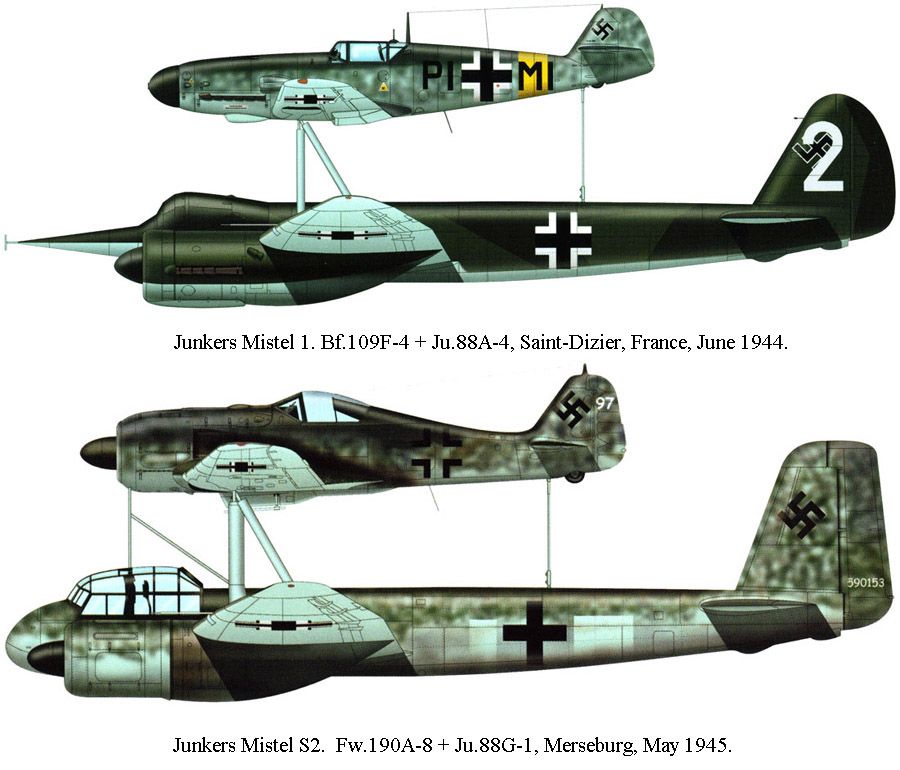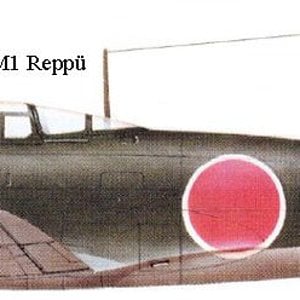Navigation
Install the app
How to install the app on iOS
Follow along with the video below to see how to install our site as a web app on your home screen.
Note: This feature may not be available in some browsers.
More options
You are using an out of date browser. It may not display this or other websites correctly.
You should upgrade or use an alternative browser.
You should upgrade or use an alternative browser.
The Mistel ('Mistletoe'), also known as Beethoven-Gerät (Beethoven Device) and Vati und Sohn (Daddy and Son), was a Luftwaffe composite aircraft type of bomber, that appeared late in World War II.
The scheme originally involved replacing the entire nose-located crew compartment of a bomber airframe (usually a Junkers Ju 88 variant) with a specially-designed nose filled with a large load of explosive, and guiding it to its target by a fighter aircraft mounted above it on a set of struts. After releasing the bomber, the fighter would return to base. The first such composite aircraft flew in July 1943 and was promising enough to begin a programme by Luftwaffe test unit KG 200, code-named 'Beethoven'.
The definitive Mistel warhead was a very large shaped charge, of nearly two short tons in weight, and fitted with a copper or aluminium liner, similar to the warhead of the much smaller Panzerfaust anti-tank weapon. The warhead was expected to have a penetration of up to 7 meters of reinforced concrete.
Some 250 Mistels of various combinations were built during the war, but met with limited success. They were first flown in combat against the Allied invasion fleet during Battle of Normandy, targeting the British-held harbour at Courseulles-sur-Mer.
Info: Wikipedia
http://en.wikipedia.org/wiki/Mistel
Profiles: Wings Palette
http://wp.scn.ru/en/
The scheme originally involved replacing the entire nose-located crew compartment of a bomber airframe (usually a Junkers Ju 88 variant) with a specially-designed nose filled with a large load of explosive, and guiding it to its target by a fighter aircraft mounted above it on a set of struts. After releasing the bomber, the fighter would return to base. The first such composite aircraft flew in July 1943 and was promising enough to begin a programme by Luftwaffe test unit KG 200, code-named 'Beethoven'.
The definitive Mistel warhead was a very large shaped charge, of nearly two short tons in weight, and fitted with a copper or aluminium liner, similar to the warhead of the much smaller Panzerfaust anti-tank weapon. The warhead was expected to have a penetration of up to 7 meters of reinforced concrete.
Some 250 Mistels of various combinations were built during the war, but met with limited success. They were first flown in combat against the Allied invasion fleet during Battle of Normandy, targeting the British-held harbour at Courseulles-sur-Mer.
Info: Wikipedia
http://en.wikipedia.org/wiki/Mistel
Profiles: Wings Palette
http://wp.scn.ru/en/








